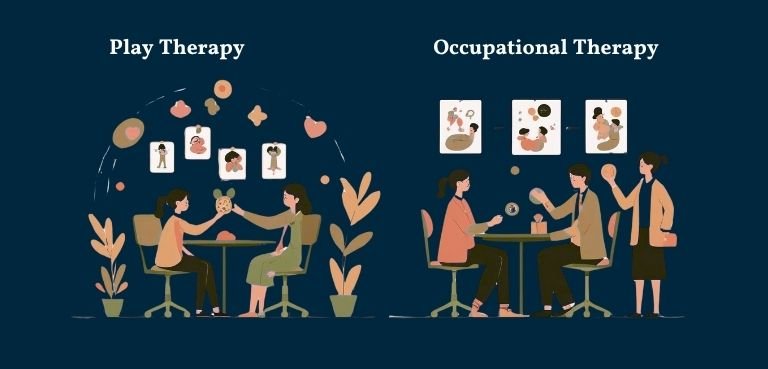No products in the cart.
Play therapy supports emotional expression through play. Occupational therapy builds skills for daily life. Knowing the difference helps children thrive. In schools and early years settings, two terms come up a lot when supporting children’s development: play therapy vs occupational therapy. They sound similar.
Both involve working with children. Both often happen in school hours. But they serve very different purposes. If you’re a teacher, SENCO, or early years practitioner, understanding what each one does – and when to refer – can make all the difference.
This blog breaks down the roles, benefits, and methods of each approach. You’ll leave with a clearer picture of what children need, and how to help them get it.

What Is Play Therapy?
Play therapy supports children’s emotional and mental health through the natural language of play. Unlike talking therapies for adults, this method meets children at their developmental level. Toys, drawings, puppets, and games become the tools for expression.
Play therapists don’t just “play.” They’re trained to observe, reflect, and guide. Their goal is to help the child express thoughts or feelings they can’t put into words.
Children who have experienced trauma, loss, anxiety, or behavioural challenges often benefit the most. But it’s not just for crises. Some children need a safe, supportive space to explore tricky emotions or build emotional resilience.
Common goals in play therapy:
- Improve emotional regulation
- Process trauma or grief
- Reduce anxiety or aggression
- Strengthen self-esteem
- Support attachment and trust
A play therapy session might look like a child drawing a story about their family. Or they may create a scene with toy figures that mirrors real life. The therapist watches, listens, and helps the child make sense of what they’re showing. It’s deep work – done in a way that feels safe and child-led.
What Is Occupational Therapy?
Occupational therapy (OT) helps children develop the skills they need for daily life. In early years and school settings, that often means motor skills, sensory processing, and independence.
The term “occupation” in this context doesn’t mean work. It means the tasks and roles a person takes on every day. For a child, that might be:
- Holding a pencil
- Getting dressed
- Using cutlery
- Paying attention
- Managing transitions
OTs assess the child’s ability to do these things. They then create practical plans to build skills and confidence.
Occupational therapists may help a child improve their grip strength. They might offer tools like wobble cushions for better focus. Or they may teach techniques for managing sensory overload in a noisy classroom.
It’s a hands-on approach. Often playful, but always functional.
Play Therapy vs Occupational Therapy: What’s the Core Difference?
Here’s the simple breakdown:
- Play therapy supports emotional and psychological wellbeing.
- Occupational therapy supports physical and functional development.
Both can use playful methods. Both aim to support the whole child. But their focus – and their training – is very different.
When dressing is a struggle, occupational therapy can help. After a loss, play therapy might be what’s needed. For trouble focusing, it could be either – or both.
Knowing which to choose isn’t always obvious. But understanding each one’s purpose can guide the way.
When to Refer to Play Therapy
Teachers often notice emotional struggles before anyone else. If a child seems withdrawn, overly anxious, or aggressive, it could be a sign they need help beyond classroom strategies.
Refer to play therapy when a child:
- Has experienced trauma or loss
- Displays sudden changes in behaviour
- Struggles with anxiety or low mood
- Has difficulty forming relationships
- Can’t express feelings in words
Play therapists provide a confidential space. It’s not about “fixing” behaviour. It’s about helping the child understand themselves and feel safer in the world.
Sessions are child-led. This builds trust and helps children feel in control. Over time, many children show improvements in confidence, social skills, and emotional regulation.
When to Refer to Occupational Therapy
You might notice a child who can’t hold a pencil properly, or tires quickly when writing. Maybe they avoid messy play or struggle to sit still. These signs often point to physical or sensory challenges – areas where an OT can help.
Refer to occupational therapy when a child:
- Struggles with fine or gross motor skills
- Finds handwriting or drawing tiring
- Avoids sensory input (like noise or touch)
- Has trouble with self-care tasks (like buttons or cutlery)
- Struggles to focus or transition between tasks
OTs can assess posture, grip, balance, and more. They’ll often work with teachers and parents to create a plan. The aim is always to boost independence and confidence.
Can a Child See Both Therapists?
Yes – and many do. In fact, a joined-up approach often works best. Emotional distress can affect motor skills. Sensory issues can impact mood. These areas overlap more than people think.
A child may work with a play therapist to process early trauma, while also seeing an OT to develop fine motor skills. Communication between therapists is key. That way, the support wraps around the child rather than becoming a tug of war.
The goal is always the same: helping the child to thrive in their environment.
Common Myths About Play and Occupational Therapy
Myth 1: “It’s just playing.”
Not true. Both therapies involve structured, goal-based sessions. They use evidence-based techniques, guided by clear aims.
Myth 2: “Only children with diagnoses need therapy.”
Also false. Many children without formal diagnoses benefit from short-term support. Early help prevents long-term problems.
Myth 3: “It’s either one or the other.”
Wrong again. Sometimes it’s both. Sometimes one leads to the other. The key is understanding the child’s needs.
How These Therapies Support Whole-Child Development
Children don’t grow in parts. Emotional and physical development work together. When one area struggles, the other often does too.
A child with sensory issues may feel anxious in busy spaces. A child with low self-esteem may avoid tasks they find hard. By understanding the role of both therapies, you support the whole child – not just the loudest symptom.
This is especially important in early years and key stages 1 and 2. These are the prime years for laying down strong foundations.
Spotting the Signs: A Quick Checklist for Educators
Here’s a quick-reference guide for spotting when to refer, based on what you observe in class.
Of course, every child is different. These signs are just indicators, not diagnoses. But they can help you start the right conversations.
How Teachers and SENCOs Can Make the Referral Process Smoother
Good communication is everything. If you think a child could benefit from therapy, document what you see. Speak with parents or carers. Be clear about what the concern is, and why you think therapy could help.
Involve your SENCO or safeguarding lead early. Many therapists will also do an observation or assessment before starting regular sessions.
And always keep the child’s voice at the centre. Therapy works best when it’s welcomed, not forced.
Play Therapy vs Occupational Therapy: What It Means for Your Setting
You don’t need to be a therapist to support a child. But knowing the difference between play therapy and occupational therapy gives you power. It helps you advocate. It helps you act early. And it builds a shared language between staff, families, and therapists.
You become a bridge – helping the child get from struggle to support.
In the end, it’s not about choosing between “play” or “function.” It’s about knowing when each one matters most.
Ready to Deepen Your Understanding?
Understanding children’s behaviour and needs takes more than instinct. Our Cognitive Behavioural Therapy Training Online at Wise Campus gives you practical tools to support mental health, emotions, and development. Whether you’re in early years, SEN, or education leadership, you’ll gain insights you can use every day.
Enrol now and learn how to support every child with confidence.







